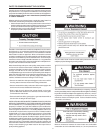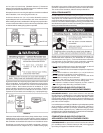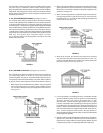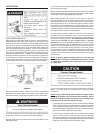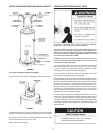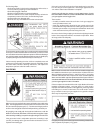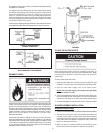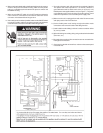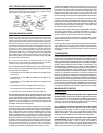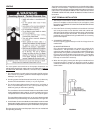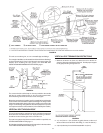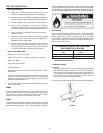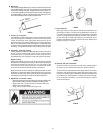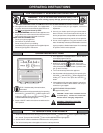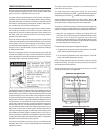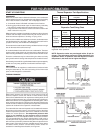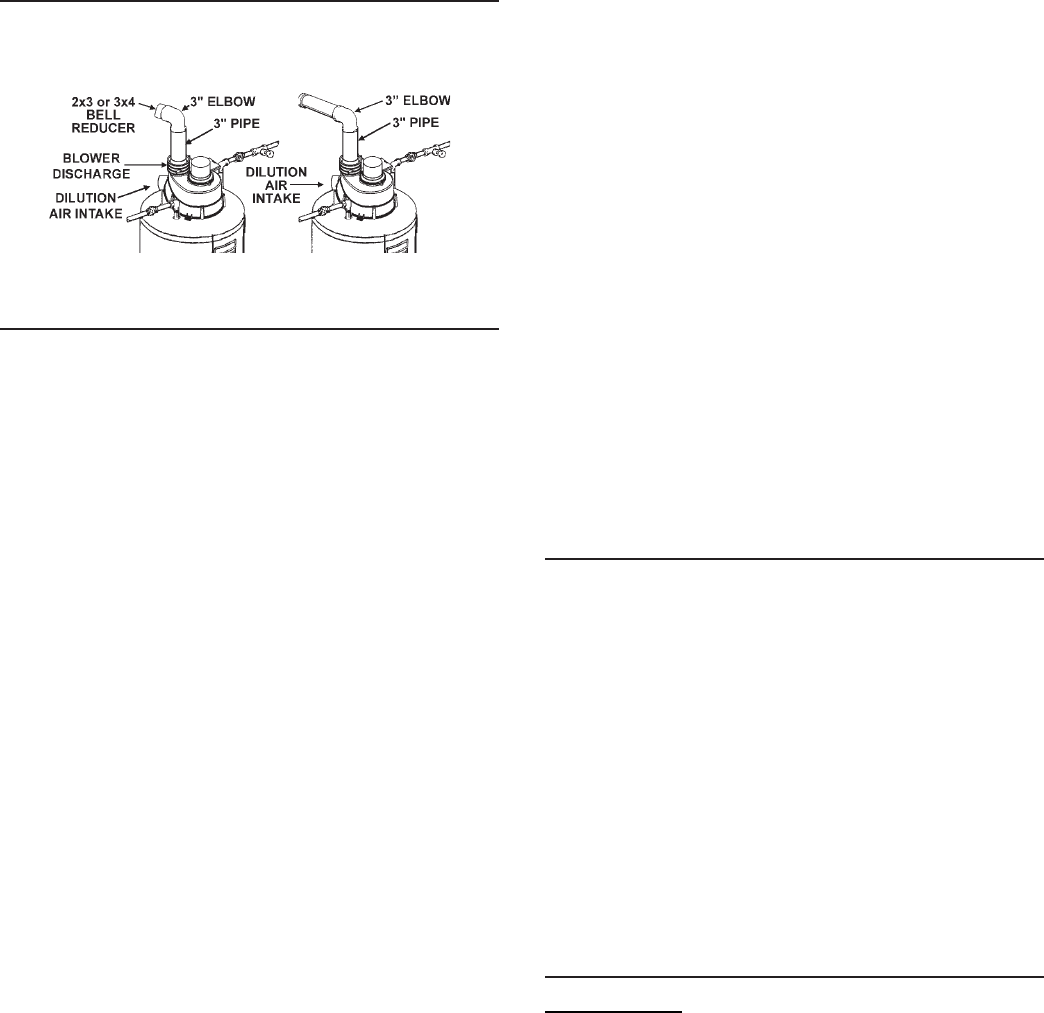
17
VENT CONNECTIONS TO BLOWER ASSEMBLY
Figure 21 shows the optimal placement of the 2" to 3" or 3" to 4" reducer;
however, the vent can be reduced at any point in the vent system as long
as the maximum vent length is not exceeded.
FIGURE 21.
VENTING AND INSTALLATION
Plan the layout of the vent system from the vent termination to the water
heater considering all of the 90° and 45° elbows plus the number of feet
of pipe that would be needed to install the total vent system. The water
heater must be vented to the outdoors as described in these instructions.
DO NOT connect this water heater to an existing vent or chimney. It must
be vented separately from all other appliances. Nonmetallic vent may be
used if it has “Heat Deflection Temperature” (HDT@66 psi) or 455 kPa of
at least 157°F or 69°C. Typical nonmetallic vent materials meeting this
requirement are: PVC (Schedule 40, ASTM D-1785), Coex Cellular Core
(Schedule 40, ASTM F-441), CPVC (Schedule 40, ASTM D-2846), ABS
(Schedule 40, ASTM D-2661). The fittings, other than the supplied Vent
Termination should be equivalent to the following: PVC (Schedule 40,
DWV, ASTM D-2665), CPVC (Schedule 40, DWV, ASTM F-438), ABS
(Schedule 40 DWV, ASTM D-2661).
The cement used should be as recommended by the vent pipe
manufacturer. See the instructions on pages 20 and 21 for the proper
method of cutting and cementing the PVC pipe and fittings.
The unit may be vented horizontally through a wall or vertically through
the roof. Pipe runs must be adequately supported along both vertical
and horizontal runs as follows:
• For Schedule 40, 2" PVC, ABS, Coex Cellular Core vent pipe: Every
3 feet (0.9 m).
• For Schedule 40, 3" PVC, ABS, Coex Cellular Core vent pipe: Every
3.5 feet (1.1 m).
• For Schedule 40, 4" PVC, ABS, Coex Cellular Core vent pipe: Every
4 feet (1.2 m).
• For Schedule 40, 2" CPVC vent pipe: Every 5 feet (1.5 m).
• For Schedule 40, 3" CPVC vent pipe: Every 6 feet (1.8 m).
• For Schedule 40, 4" CPVC vent pipe: Every 6.5 feet (2.0 m).
It is imperative that the first hanger (or support) be located on the horizontal
run immediately adjacent to the first 90-degree elbow from the vertical
rise. Support method used should isolate the vent pipe from the floor
joists or other structural members to prevent the transmission of noise
and vibration. Do not support, pin, or otherwise secure the venting
system in a way that restricts the normal thermal expansion and
contraction of the chosen venting material.
If the water heater is being installed as a replacement for an existing
power vented heater in pre-existing venting, a thorough inspection of
the existing venting system must be performed prior to any installation
work. Verify that the correct material as detailed above has been
used, and that the minimum or maximum vent lengths and terminal
location as detailed in this manual have been met. Carefully inspect the
entire venting system for any signs of cracks or fractures, particularly
at the joints between elbows and other fittings and the straight runs of
vent pipe. Check the system for signs of sagging or other stresses in
the joints as a result of misalignment of any components in the system.
If any of these conditions are found, they must be corrected in
accordance with the venting instructions in this manual before
completing the installation and putting the water heater into service.
Except where instructed in this manual, the mixing of 2", 3" and 4" vent
pipe is NOT ALLOWED. If 2" pipe is to be used, then a 2" to 3" bell reducer
is recommended. Figure 21 shows the recommended location for the
bell reducer. If the bell reducer is located at the rubber boot on the
blower assembly, then a short section of 3" vent pipe needs to be
installed in the rubber boot for proper connection of the 2" to 3" bell
reducer. That length can be the minimum length required for the connection.
If 4" pipe is to be used, then a 3" to 4" bell reducer is recommended.
Figure 21 shows the recommended location for the bell reducer. If the
bell reducer is located at the rubber boot on the blower assembly, then
a short section of 3" vent pipe needs to be installed in the rubber boot
for proper connection of the 3" to 4" bell reducer. That length can be
the minimum length required for the connection.
The water heaters covered by this manual are supplied with a 2" Schedule
40 PVC 22.5° Vent Terminal. If you decide to vent with 3" or 4" pipe, a
Schedule 40 DWV 45° Vent Terminal must be used. For your convenience,
we have included a screen for both 3" and 4" Vent Terminals.
The vent piping should be connected to the blower with a rubber
adapter and secured with hose clamps. The adapter and clamps are
provided with the heater.
Even though the flue gas temperature leaving the blower is between
140°F (69°C) and 175°F (79°C), some installations will have water
vapor condense in the vent piping. If this occurs, then adequate means
of draining and disposing of the condensate needs to be made by
the installer.
CONDENSATION
Condensate formation does not occur in all installations of power vented
water heaters, but should be protected against on installations where it
can form in the venting system. Condensation in the venting system of
power vented water heaters is dependent upon installation conditions
including, but not limited to ambient temperature and humidity of installation
location, ambient temperature and humidity of venting space, vent
discharge and slope, and product usage. In certain conditions, installations
in unconditioned space or having long horizontal or vertical vent runs
may accumulate condensate. In these conditions, the vent pipe should
be sloped downward away from the blower assembly 1/4" (6.4 mm) per
five feet (1.5 m) of pipe but not more than 1 1/2" (3.8 cm) in the total vent
length. If the vent piping is vented level or sloped upwards away from
the blower assembly, then adequate means for draining and disposing
of the condensate needs to be made by the installer (if condensate is
detected). If you have condensate, then a 3/8" drain hose can be connected
to the built-in drain port of the rubber boot on the blower assembly. For
your convenience, the rubber boot is supplied with a removable cap on
the built-in drain port. Prior to operating the water heater, make sure the
removable cap is installed on the drain port (if a drain hose is not needed).
MAXIMUM VENT LENGTHS
40,000 BTU Units:
For 2" Venting, the maximum equivalent feet of pipe allowed
is 40 feet (12.2 m). This does not include the supplied vent termination
for the water heater. For the 2" venting, one 90° elbow is approximately
equal to 5 feet (1.5 m). One 45° elbow is approximately equal to 2.5
feet (0.8 m). It is recommended that at least 2 feet (0.6 m) of spacing
be used in between all 45° elbows and all 90°elbows.
For 3" Venting, the maximum equivalent feet of pipe allowed
is 120 feet (36.6 m). This does not include the Vent Termination (supplied
locally) for the water heater. For the 3" venting, one 90° elbow is
approximately equal to 5 feet (1.5 m). One 45° elbow is approximately
equal to 2.5 feet (0.8 m). It is recommended that at least 2 feet (0.6 m)
of spacing be used in between all 45° elbows and all 90°elbows.
For 4" Venting, the maximum equivalent feet of pipe allowed
is 160 feet (48.8 m). This does not include the Vent Termination (supplied
locally) for the water heater. For the 4" venting, one 90° elbow is
approximately equal to 8 feet (2.4 m). One 45° elbow is approximately
equal to 4 feet (1.2 m). It is recommended that at least 2 feet (0.6 m) of
spacing be used in between all 45° elbows and all 90°elbows.



